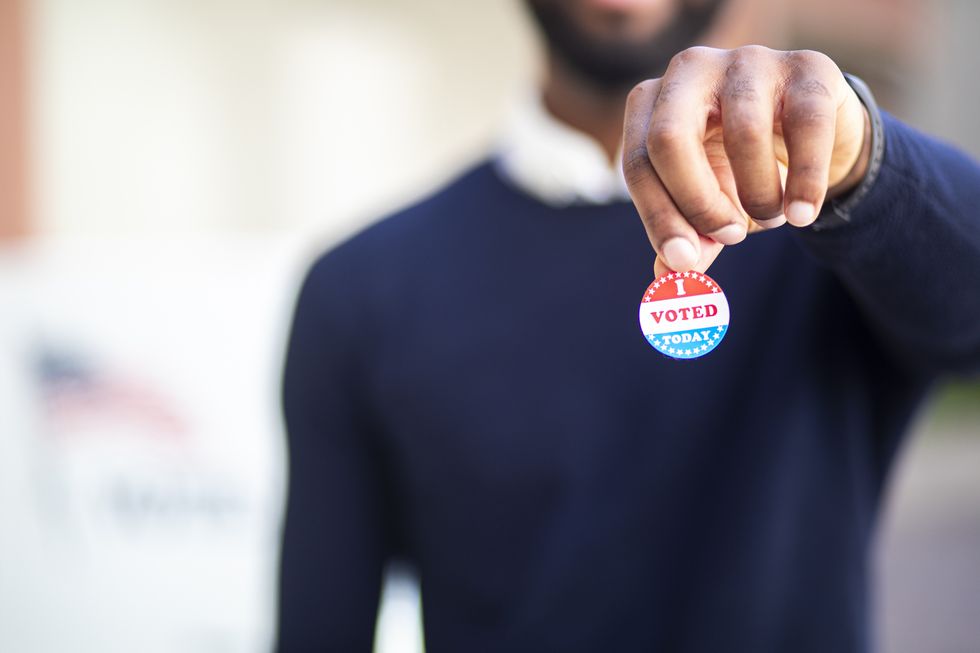The 2022 midterm elections are still more than a month away (coming in early November!), but that doesn’t mean there isn’t plenty to do and brush up on before deciding who will be your representatives on the congressional, state, and local levels. And this particular election season is crucial for the state of U.S. politics.
Below, Shondaland answers your biggest lingering midterm questions, from why they matter to how to make sure you’re registered to vote.
What happens during the midterm elections?
This year’s midterm elections take place on Tuesday, November 8. At the federal level, all 435 seats in the House of Representatives are up for grabs, as they are every two years. In the Senate, roughly one-third of all the seats are on the ballot as well. Additionally, there are a number of important state races coming up, including several gubernatorial contests in key battleground states like Florida, Pennsylvania, and Ohio. On top of that, there are countless local elections to decide everything from county clerks to sheriffs to circuit courts. If you need to brush up on who is running for what on your own local level, usa.gov offers a portal that will take you directly to your official state and local election website.
Why do the midterms matter if there’s no presidential election?
President Joe Biden has two more years left in the Oval Office, but that doesn’t mean this midterm election is any less significant. Currently, the Democrats hold only a slight majority in the House of Representatives — 220 Democrats to 212 Republicans, with three current vacancies. Democrats currently hold a tiebreaker majority in the Senate, which means that the chamber is split 50-50 by political affiliation and requires Vice President Kamala Harris’ vote if Democrats want to push their agenda forward.
While presidential candidates are not on the ballot this fall, midterm elections generally serve as a referendum on the party in power, when unhappy or apathetic moderates and the riled-up base of the party in the minority (in this case, the Republicans) use voting to express why they believe a president and his party have failed. With Biden’s fluctuating approval rating and the economy still seemingly in need of recovery, such a referendum could be on deck. On the other hand, with Trump still leading the Republican Party and pushing an agenda that many believe could put democracy in jeopardy, this could be an election that bucks the previous pattern of the party in power taking big losses in the midterms.
In any case, the 2022 midterms will be a litmus test for both political parties heading into the next general election cycle in two years. Politicians, pollsters, pundits, and the general public take the results as a harbinger of what’s to come in the future.
What’ll happen if Democrats lose control of either or both chambers of Congress?
Despite recent wins on gun reform, climate change, health care, combating inflation, and investing in American technology, Democrats faced many hurdles — including internal struggles within their own ranks — in getting legislation passed over the past two years, but it’ll become infinitely harder to make good on earlier campaign promises without majorities in both the House and Senate, however small they are.
From a Republican perspective, making gains or taking the majority in either or both of these chambers makes it easier to resist Democratic legislation and even begin making inroads on other bills and laws Republicans want to push forward in the future. For example, if Republicans were to win back one of these chambers in 2022, and then, in 2024, a Republican presidential candidate were to win the presidency, their hope would be that they have legislation ready to be voted on immediately and signed into law.
What are the most important issues the midterms could affect?
With this election, a lot:
- abortion access
- stricter gun laws
- the legalization of marijuana
- climate change
- immigration
- voting rights
- ongoing issues with inflation and the economy
These are all issues that will or won’t see significant policy pushes depending on who holds the House and the Senate.
Are there any big races you should immediately start following?
Every person’s focus will differ depending on which state they live in, but here’s a small smattering of the big races that have dominated headlines in recent months:
- Ohio U.S. Senate seat: J.D. Vance, the author of the best-selling and controversial book Hillbilly Elegy, is trying to win the seat in the major battleground state of Ohio. His opponent is Democratic congressman Tim Ryan.
- Pennsylvania U.S. Senate seat: Speaking of battleground states, Dr. Mehmet Oz (yes, from television) is facing off against the state’s current lieutenant governor, John Fetterman, in what’s been a race full of twists and turns (and memes).
- Georgia gubernatorial seat: Democrat Stacey Abrams is making another run to be the next governor of Georgia, where she’s matched up against Republican incumbent Brian Kemp. They ran against each other previously. And as you may recall, there were allegations of election stealing during their highly publicized 2018 race, as the state has faced issues of voter suppression.
- Georgia U.S. Senate seat: Democrat Raphael Warnock is looking to keep his Senate seat in the Peach State this fall. His Republican opponent is former pro football player Herschel Walker.
- Florida gubernatorial seat: Republican incumbent Ron DeSantis, who’s made it clear that he’s working toward a run for the White House at some point, is seeking reelection against former Florida governor Charlie Crist, who once led the state as a Republican but is now running as a Democrat.
Why have midterm elections become more important over the last decade?
As politics in the United States have become more polarized over the last few years, elections have begun to matter more and more if political parties want any hope of passing their legislative agendas. Slim majorities by a party can mean huge differences in policy as well as the productivity of a chamber.
How many people vote in the midterm elections?
Unfortunately, midterm elections turnout is typically lower than turnout during a presidential election year, with only about 40 percent of Americans voting in the former compared to 60 percent of Americans in the latter.
However, while turnout has, on average, continued to fall in recent decades, there have been hopeful signs of more civic engagement. With a 39.4 percent turnout, 2018 saw the average midterm turnout jump 10 points over any midterm election from the previous 40 years. In 2020, 56.5 percent of voters showed up to the polls, leading to another 10-point increase over the 40-year average for a presidential election.
Whether this upward trend will continue remains to be seen, due to a number of factors mainly around voter suppression. First, many states now have voter identification laws and other restrictions that make the barrier to entry to vote higher than ever before. Different states and counties have shut down various polling sites in recent years and consolidated them with others, meaning that some Americans can spend hours waiting in line; in turn, this makes it difficult to vote, as many people can’t afford to take that time off from work or life commitments.
However, turnout numbers are really dependent on a number of different demographics. To give some examples, young people tend to vote at lower rates than their older counterparts, and white Americans tend to vote more frequently than people of color.
Do we have any idea what the results will look like?
We’re at the point in the pre-election season where polls are still swinging a little bit, with some predicting that Republicans will sweep the House and the Senate, others saying we are headed for a Republican House and a Democratic Senate, and many describing important races as being tied. Additionally, lots of pollsters have noted that the ongoing rash of gun violence and the Supreme Court’s overturning of Roe v. Wade in late June could affect turnout and votes in ways that can’t quite be fully projected ahead of time; they can only take historical guesses. For instance, some have said that a backlash could occur in the voting booth in November after the overturning of Roe, with more women voting and using tthe vote to support candidates who support women’s rights.
How can you find more information on registering to vote and heading to the polls?
If you’re not sure about your voter status, the dates for early voting in your area, or any other information you may need for election day, check out When We All Vote or go to Vote.org to go through the process step-by-step.
Remember that certain states also require specific forms of identification to vote and/or have deadlines for when you can register, so it’s critical to check on what you’ll need for your particular state and county. You’ll also want to use the platform as well as your local election site to confirm your voting location since that may have changed since you last cast a ballot.
Lily Herman is a New York-based writer and editor. You can find her on Twitter.
Get Shondaland directly in your inbox: SUBSCRIBE TODAY














